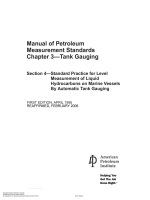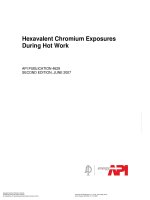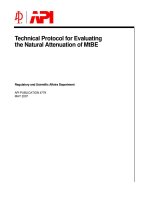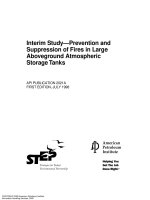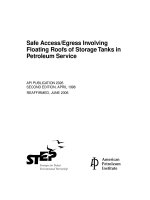Api publ 4736 2006 (american petroleum institute)
Bạn đang xem bản rút gọn của tài liệu. Xem và tải ngay bản đầy đủ của tài liệu tại đây (354.92 KB, 64 trang )
Identification of Key Assumptions and
Models for the Development of Total
Maximum Daily Loads
Regulatory Analysis and Scientific Affairs
Publication Number 4736
November 2006
Identification of Key Assumptions and
Models for the Development of Total
Maximum Daily Loads
Regulatory and Scientific Affairs
API PUBLICATION 4736
FIRST EDITION, NOVEMBER 2006
PREPARED BY:
Tischler/Kocurek
Round Rock, Texas
ACKNOWLEDGMENTS
THE FOLLOWING PEOPLE ARE RECOGNIZED FOR THEIR CONTRIBUTIONS OF TIME
AND EXPERTISE DURING THIS STUDY AND IN THE PREPARATION OF THIS
REPORT:
API STAFF CONTACT
Roger Claff, Regulatory Analysis and Scientific Affairs
MEMBERS OF THE CLEAN WATER ISSUES TASK FORCE
Rees Madsen, Task Force Chairman, BP P.L.C.
John Cruze, Task Force Vice Chairman, ConocoPhillips
Jeffrey Adams, BP America Incorporated
Gregory Biddinger, ExxonMobil Refining and Supply Company
Mickey Carter, ConocoPhillips
Robert Goodrich, ExxonMobil Research and Engineering
John King, Marathon Ashland Petroleum
Susie King, ConocoPhillips
Jonnie Martin, Shell Oil Products US
Pat Netsch, ChevronTexaco Corporation
Pepsi Nunes, Marathon Ashland Petroleum LLC
David Pierce, ChevronTexaco Corporation
Jeff Richardson, BP P.L.C.
George Stalter, BP P.L.C.
Kim Wiseman, ChevronTexaco Corporation
Jenny Yang, Marathon Oil Company
David Zabcik, Shell Oil Products US
Identification of Key Assumptions and Models for the Development of Total
Maximum Daily Loads
Abstract
This study identifies and reviews the most widely used, publicly available watershed and
receiving water models used in total maximum daily load (TMDL) analysis. These models are
the primary tool states and EPA use to establish TMDLs, the pollutant loading budgets required
when a state determines that a surface water body does not achieve applicable surface water
quality standards. Applicable models range from simple mass balances to highly sophisticated
computer models that simulate dynamic water quality variations. Watershed models are used to
predict point and nonpoint source pollutant loadings in runoff from different types of land use.
Receiving water models are used to predict receiving water quality as a function of pollutant
loadings and hydrologic conditions. The applicability of these models and their complexity, input
data requirements, and prediction capabilities are described. The most important model input
requirements for developing scientifically supported water quality simulations are identified and
prioritized. In the case of watershed models, the most important variables are: (1) the physical
characteristics of the watershed; (2) the land uses; and (3) the loading functions that relate
pollutant loadings to land use. The key data requirements for receiving water models are: (1) the
adequate characterization of hydraulics, which governs the transport of pollutants; (2) the
pollutant transformation rates; and (3) the pollutant sources. The review of available TMDL
models emphasizes that site-specific data must be available to calibrate and validate whichever
model is selected to meet the TMDL objectives. An essential element of any TMDL is validation
of water quality model predictive capability, using a field data set that is independent of the data
used for model calibration. Also, a component of every TMDL should be sensitivity analyses of
model predictions to allow probability analysis of uncertainty.
Table of Contents
Page
1
Introduction ......................................................................................................... 1
Objective ............................................................................................................... 2
Scope
....................................................................................................... 2
Organization ....................................................................................................... 3
2
Summary of TMDL Modeling.............................................................................. 4
TMDL fundamentals .............................................................................................. 4
Watershed models ................................................................................................ 5
Receiving water models ........................................................................................ 8
3
TMDL Fundamentals ......................................................................................... 10
Modeling fundamentals ....................................................................................... 11
Scoping the TMDL study ..................................................................................... 13
Selecting a model................................................................................................ 16
Boundary conditions (pollutant loadings) ............................................................ 18
4
Watershed Models............................................................................................. 21
Loading equations ............................................................................................... 22
Comprehensive watershed modeling .................................................................. 23
Selecting a watershed modeling approach ......................................................... 26
Data sources for watershed models.................................................................... 29
5
Receiving Water Models ................................................................................... 31
Steady state models............................................................................................ 32
Dynamic models.................................................................................................. 36
Boundary conditions............................................................................................ 41
Other models....................................................................................................... 43
Websites.............................................................................................................. 47
References .......................................................................................................... 48
List of Tables
Page
2-1
Fundamental Development of TMDL Development ........................................... 5
2-2
Watershed Model Selection Considerations ...................................................... 6
2-3
Key Watershed Model Variables ........................................................................ 7
2-4
Receiving Water Model Selection Considerations ............................................. 8
2-5
Key Receiving Water Model Variables ............................................................... 9
3-1
Watershed Model Simulation Capabilities........................................................ 17
3-2
Receiving Water Model Simulation Capabilities ............................................... 19
4-1
Example Watershed Equations ....................................................................... 22
4-2
Input Data for Watershed Equations ................................................................ 23
4-3
Examples of Comprehensive Watershed Models ............................................ 25
4-4
Selecting a Comprehensive Watershed Model ................................................ 27
4-5
Data Sources for Watershed Models ............................................................... 29
5-1
Examples of Steady-state Water Quality Models ............................................. 33
5-2
Data Requirements for Steady-state Water Quality Models............................. 35
5-3
Examples of Dynamic Water Quality Models ................................................... 37
5-4
Data Requirements for Dynamic Water Quality Models ................................... 40
5-5
Steady-state Model Boundary Conditions ........................................................ 42
5-6
Dynamic Model Boundary Conditions .............................................................. 43
5-7
Examples of Mixing Zone Models .................................................................... 45
5-8
Examples of Ecological Models........................................................................ 46
List of Figures
Page
3-1
Selecting the Geographic Area for the TMDL .................................................. 15
4-1
Selection and application of watershed models ............................................... 30
Executive Summary
The American Petroleum Institute (API) commissioned this evaluation of models for developing
total maximum daily loads (TMDL) as required by Section 303(d) of the Clean Water Act.
TMDLs are required when a state determines that a surface water body does not achieve
applicable surface water quality standards. The TMDL is designed to identify the pollutant
sources causing and/or contributing to the impaired water quality, and to determine allowable
point and nonpoint source pollutant loadings that will assure the water quality standard is
achieved.
Water quality models are the primary tool states and EPA use to establish TMDLs. Applicable
models range from simple mass balances to highly sophisticated computer models that simulate
dynamic water quality variations. There are two basic categories of models used for TMDL
studies: (1) watershed models, and (2) receiving water models. Watershed models are used to
predict point and nonpoint source pollutant loadings in runoff from different types of land use.
Receiving water models are used to predict receiving water quality as a function of pollutant
loadings and hydrologic conditions. Some comprehensive models link watershed pollutant load
prediction and receiving water quality effects analysis. Dynamic water quality models are
available to simulate temporal variations in water quality. Ecological models are receiving water
models that simulate chemical transport and transformation in aquatic food webs. Publicly
available watershed and receiving water models are available for virtually every category of
TMDL. Generally, a publicly available model that is well documented and has been
demonstrated to generate scientifically acceptable predictions should be used for TMDLs.
The data requirements for watershed and receiving water models become increasingly
demanding as the models become more complex and sophisticated. Model selection must
consider the nature of the water quality impairment and the complexity of the model needed to
adequately simulate the source-effect relationship. As a general rule of thumb, the entity
performing the TMDL should select the least complex model that meets the TMDL objectives.
This study identifies and reviews the most widely used, publicly available watershed and
receiving water models. The applicability of these models and their complexity, input data
requirements, and prediction capabilities are described. The most important model input
requirements for developing scientifically supported water quality simulations are identified and
prioritized. In the case of watershed models, the most important variables are: (1) the physical
characteristics of the watershed; (2) the land uses; and (3) the loading functions that relate
pollutant loadings to land use. The key data requirements for receiving water models are: (1) the
adequate characterization of hydraulics, which governs the transport of pollutants; (2) the
pollutant transformation rates; and (3) the pollutant sources. Section 2 of the report summarizes
the most important data for each type of watershed and water quality model described in this
report.
The review of available TMDL models emphasizes that site-specific data must be available to
calibrate and validate whichever model is selected to meet the TMDL objectives. An essential
element of any TMDL is validation of water quality model predictive capability, using a field
data set that is independent of the data used for model calibration. Also, a component of every
TMDL should be sensitivity analyses of model predictions to allow probability analysis of
uncertainty
.
Introduction
Section 1
This report is intended to provide the reader with an understanding
of the use of models in the development and implementation of
total maximum daily loading (TMDL) studies. The Clean Water
Act (CWA, Section 303(d)) requires a TMDL when a surface
water body does not achieve a surface water quality standard or
designated use.1 Regulations promulgated by the U.S.
Environmental Protection Agency (EPA) require states and tribes
to perform TMDLs for all water bodies under their jurisdiction that
they have identified as impaired waters pursuant to the provisions
of Section 303(d)(1) of the CWA. Section 303(d)(2) requires EPA
to approve or disapprove state lists of impaired waters and TMDLs
developed by states to eliminate the impairments. If a TMDL is
approved, the TMDL is to be incorporated into the state’s
continuing planning process required by Section 303(e). If EPA
disapproves a state’s TMDL, then EPA is required to develop the
TMDL and the state must include the EPA-derived TMDL into its
continuing planning process.
Water quality models, which simulate the fate and transport of
pollutants, are the principal tools that are used to develop and
implement a TMDL. These models are designed to be predictive
tools that will allow the regulatory agency to determine the amount
of reductions in pollutant loading that will be required of each
contributing source in order to assure that the surface water
achieves the relevant water quality criterion and/or designated use.
Because models are central to the development and
implementation of TMDLs, the American Petroleum Institute
(API) Clean Water Issues Task Force commissioned this review of
the types of models used for TMDL studies and the assumptions
underlying their development and use.
1
Section 303(d)(1)(A) identifies these as surface waters where technology-based effluent standards
promulgated pursuant to Sections 301(b)(1)(A) and (B) are not stringent enough to implement any
applicable water quality standard. Such surface waters are referred to as “impaired.”
American Petroleum Institute
TMDL Model Development
Section 1
1
Objective
This report focuses on the types of models used for TMDLs, the
key assumptions underlying the models, how models are selected
for specific surface waters and impairments, the data required to
apply the models to a specific surface water and impairment, and
how the predictive capability of the models is assessed.
EPA has published a report entitled Compendium of Tools for
Watershed Assessment and TMDL Development.2 EPA’s
Compendium provides detailed descriptions of most of the models
that are included in this review. The Water Environment Research
Foundation (WERF) has also published a survey and assessment of
water quality models that is available as a CD-ROM.3 This API
review is not intended to be a substitute for EPA’s Compendium,
other EPA guidance, the WERF assessment, and published
technical references on water quality modeling. The reader should
refer to the EPA compendium and WERF report for more detailed
descriptions of watershed and water quality models. A list of
published references on modeling is included in this report.
Scope
This review covers different types of water quality models applied
to TMDLs performed to date. It also includes models
recommended for, but not necessarily applied to, TMDLs. Because
there are literally dozens of water quality models, both public and
proprietary, this review focuses on well-documented models that
are in the public domain and most commonly recommended for
TMDL use. A range of model complexity is represented in this
review. Models that are applicable to a wide range of surface water
constituents were evaluated for this study.
This report is designed to inform users about the application of
models to specific types of TMDL problems, with emphasis on
assuring that predictions of water quality are as reliable and
accurate as practical, given the time and resources available to
conduct the TMDL. This review does not recommend any specific
model for any particular application.
2
EPA, 1997, Compendium of Tools for Watershed Assessment and TMDL Development, EPA 841-B-97006, Office of Water, Washington, D.C.
3
WERF, 2001, Water Quality Models: A Survey and Assessment, Order No. D13209TC (CD-ROM),
Washington, D.C.
American Petroleum Institute
TMDL Model Development
Section 1
2
Organization
This report is organized into the following sections:
1. Introduction;
2. Summary of TMDL modeling;
3. TMDL Fundamentals;
4. Watershed Models; and
5. Receiving Water Models.
A list of websites for downloading the publicly available models
described in this report is presented at the end of the report. A list
of references on TMDLs and models is also provided following the
website list.
American Petroleum Institute
TMDL Model Development
Section 1
3
Summary of TMDL Modeling
Section 2
The objective of this study was to review federal, state, and
regional TMDL methodologies and guidance to identify key
assumptions, variables, and input data required to develop waste
load allocations (WLA) for point sources and load allocations (LA)
for non-point sources that, when implemented, will restore water
quality in an impaired water body so that it meets applicable water
quality criteria and designated uses. The review focused on the
models available to federal, state, regional, and local regulatory
authorities to perform TMDL studies. The term “models” is used
in its broadest sense, ranging from simple desktop calculations to
complex mathematical models that must be run on powerful
computers.
The review is broken into 3 categories:
(1) an overview of TMDL modeling including how models are
selected and how the boundaries of the water body to be
modeled are specified;
(2) watershed models used to predict point and non-point source
pollutant loadings from sub-watersheds and watershed; and
(3) receiving water quality models that are used to predict the
transport and fate of specific water quality constituents in a
surface water body.
The conclusions drawn from this review are presented in this
summary section.
TMDL Fundamentals
Fundamental steps in the TMDL process are: identifying water
quality constituents causing the impairment, determination of the
geographic boundaries, selection of the modeling approach for
developing quantitative WLAs and LAs, selecting the appropriate
critical hydrologic conditions, and calibrating and validating the
selected model(s). The principal considerations in these steps are
summarized in Table 2-1.
American Petroleum Institute
TMDL Model Development
Section 2
5
Table 2-1
Fundamental Requirements of TMDL Development
Consideration
Criteria to protect designated
uses (i.e., cause of
impairment)
Geographic boundaries
Requirements
Must be numeric and for a specific constituent(s) —
either a water quality standard or a causal variable
Narrative standards (e.g., “no toxics in toxic
amounts”) must be addressed with a numeric
translator
TMDLs cannot be developed until causal water
quality variables are identified
Must encompass all significant pollutant sources
Exclusion of sub-watersheds that do not and will
not contribute to impairment is cost-effective
Model selection basis
Data requirements
Uncertainty analysis
Physical characteristics of the watershed and/or
water body
Constituents to be simulated
Temporal variation in water quality (e.g., seasonal,
annual, event-related)
Sources of pollutants
Hydrologic regime(s) associated with impairment
Data availability and resources to generate
adequate database
Simple model appropriate if default data must be
used for many parameters
Field data for model calibration and validation
Background conditions based on field data at unimpacted locations
Uncertainty of model predictions must be included
in the TMDL
Sensitivity analysis of key model variables must be
conducted and presented
Watershed Models
Watershed models are used to simulate the entrainment of
pollutants (including sediment) from ground surfaces by
precipitation and subsequent surface water runoff and transport of
the pollutants to surface waters. Watershed models may be used to
generate inputs to receiving water quality models or may include
their own receiving water modeling capability. Important
considerations in the selection and use of watershed models are
identified in Table 2-2.
American Petroleum Institute
TMDL Model Development
Section 2
6
Table 2-2
Watershed Model Selection Considerations
Consideration
Model complexity
Data needs
Comments
Simple models and equations are only appropriate
for screening purposes (i.e., importance of nonpoint sources)
Accommodate sufficient site-specific detail for
reliable cause-effect predictions
Temporal variations in water quality to be evaluated
(i.e., hourly, daily, seasonal, annual)
Receiving water simulation capability built-in or
linked?
Evaluate required inputs for associated receiving
water model(s)
Model requirements are determined by model
complexity: more complex = more data
Data must represent full range of hydrologic
conditions to be considered
Sufficient site-specific data for model calibration
and validation
Table 2-3 summarizes the most important watershed model input
variables, in order of their relative importance. When using this
table it should be understood that for any specific watershed and
TMDL study, the relative importance of some of the variables
shown in Table 2-3 to achieving the study objectives may change.
Also, although they are very important variables to reliable model
simulations, watershed physical characteristics and land uses are
also generally the easiest variables to obtain accurate data on.
Therefore, a great deal of effort is not usually required to assure
that these important variables are adequately represented in a
watershed model.
American Petroleum Institute
TMDL Model Development
Section 2
7
Table 2-3
Key Watershed Model Variables
Variable
Physical characteristics — soil
types, slopes, streams (1st, 2nd,
and 3rd order)
Importance of SiteSpecific Data
Essential
Land use
Essential
Pollutant loading rates
Moderate
Precipitation-runoff rate
coefficients
Moderate
Pollutant transformation
coefficients (e.g., sedimentation
rates, biological or chemical
removal)
Low
American Petroleum Institute
TMDL Model Development
Comments
Physiographic characteristics of the
watershed are single most important
component
Required watershed physical detail is
dependent upon the model selected and
the TMDL objectives
Storm event modeling (short-term
predictions of runoff) requires most
detailed physiographic characterization
Usually readily available with accurate
information
Confirm that appropriate data sources and
detail are included in the model
Land uses determine the runoff rates and
pollutant loadings generated the model
Detail required is based on the model and
TMDL objectives.
Requirements and data availability for
land use are similar to those of physical
characteristics.
Confirm that appropriate data sources and
degree of detail are appropriate for model
and objectives
Empirical coefficients or factors that are
used to calculate pollutant loadings as a
function of land use
Pollutant loading rates must account for
antecedent rainfall-runoff events In
complex models that predict runoff event
loadings
Loading rate coefficients must allow
evaluation of land management practices.
Rates are a function of land use and
physical characteristics (slope, soil type)
Must allow adjustments to represent
various land management practices
Should account for antecedent rainfall
events in complex models that predict
runoff event loadings
Typically are only important when a
watershed model is linked to a receiving
water model
Transformations (physical, chemical,
biological) included are based on
pollutants simulated
Section 2
8
Receiving Water Models
Receiving water models of some form will be at the heart of all
TMDLs. These models will be used to predict the WLAs and LAs
that are necessary to assure that an existing water quality
impairment will be eliminated and that water quality and uses will
be protected in the future. Therefore, selection and application of
receiving water models will be one of the most important, if not
the most important, aspects of TMDL development and
implementation. There are a number of publicly available
receiving water models that can be used for TMDLs. Any of the
models reviewed for this project will give acceptable simulation
results provided that the model is appropriate for the surface water
body modeled and sufficient site-specific data are available for
calibration and validation. Table 2-4 summarizes the principal
considerations in the selection of receiving water models.
Table 2-4
Receiving Water Model Selection Considerations
Consideration
Model complexity
Comments
Need for simulating temporal variations in water
quality is a fundamental consideration
Models that simulate steady-state hydrodynamic
transport of pollutants will suffice for many (most?)
TMDLs
Steady-state hydrodynamic models can simulate
time-variable water quality for selected pollutants
Dynamic modeling of hydrodynamic transport of
pollutants is necessary if transient variability of
water quality is important
Linkage to watershed model is necessary if
transient runoff events must be modeled
Data needs
Physical description of surface waters
Data must represent full range of hydrologic
conditions to be considered
Time-variable hydrologic and hydraulic data are
required for dynamic modeling of pollutant transport
Sufficient site-specific data for model calibration
and validation
The key variables in receiving water models are identified in Table
2-5. They are shown in approximate order of importance.
However, it must be understood that the specific receiving water,
target pollutants, and TMDL objectives are important determinants
of the relative importance of the model variables.
American Petroleum Institute
TMDL Model Development
Section 2
9
